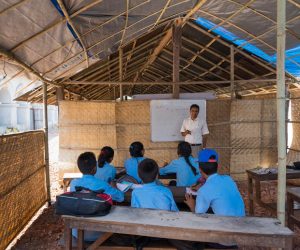Natural disasters affect millions every year and their impact is cataclysmic. These calamities wreak havoc, forcing people to abandon their homes. Lives are lost and large-scale evacuations disrupt accessibility to basic hygiene, education, health care and most importantly food supplies.
In the past decades, almost every nation has been impacted by the effects of natural calamities. Hence in 2001, the United Nations Intergovernmental Panel on Climate Change, where over 2,000 scientists from 100 countries participated; concluded that it is the humans who are playing the predominant role in causing these alarming changes in climate.

COP 21, 2015 reiterates the same notion. This seminal conference held in Paris, came together with the aim to improve the present scenario of global climate change. Delegates negotiated to reach a legally binding climate change agreement for all the nations of the world. This new universal climate change agreement expects to keep the ‘increase in global temperature below 2 degree Celsius’. This objective was earlier recognized in COP15, hosted in 2009 in Copenhagen but no all abiding agreement was reached upon.
Every nation is aware that with the current rate at which atmospheric warming and carbon dioxide accumulation is happening; things are going to get worse without intervention. Alpine and Polar ice is melting, the oceans are heating up, circumpolar winds are gearing pace and moreover the stratosphere is heating up causing the ‘ozone shield’ to grow thinner. Given the present rate of carbon dioxide buildup, it is evident that the world is entering uncharted seas.
These natural calamities triggered by anthropogenic actions have widespread effects on the entire population especially the children. Displaced populations, health risks, food security, emotional aftershocks and education for children are the most hit sectors affecting child health during a natural disaster.

Food insecurity becomes extreme after natural calamities hit a nation. Millions of children starve owing to the failing crops and dearth of agricultural supplies. Children experience hunger crisis leading to ill health, starvation, under-nutrition and disease. Respiratory diseases and immunosuppression is manifested visibly in the affected children. Hunger pangs become widespread and the child mortality rate is hit.
Hunger gives rise to malnutrition in children. This is majorly caused due to insufficient nutrients in food supplies. This leads to severe weight loss and stunting of growth. According to the British Medical Journal, “malnutrition in children can also adversely hinder brain development and intellectual capacity in the early stages of life.”
The child psyche is also perturbed by the effects of a natural disaster. Loss of home and loved ones create in children a sense of emotional insecurity leading to emotional distress often known as Post-Traumatic Stress Disorder (PTSD). This leads to low concentration and increased irritability causing education to suffer. Children constantly manifest different behavioural pattern that acts as a detriment for their cognitive thinking.
Education suffers immensely due to these anthropogenic natural calamities. Educational facilities are destroyed and paucity of funds leads to sluggish recovery of schools and affected infrastructure. In the 2010 Haiti earthquake, over 4,000 schools were affected and took several months to resume classes. Similarly, 11,000 schools collapsed in the Pakistan Floods back in 2010 while the earthquake in 2005 killed more than 17,000 children.
Cambodia’s children have also been similarly affected – kids accounted for 80% of deaths in the devastating floods of 2000; whilst floods in 2001 and 2002 also caused extensive destruction to school infrastructure. Death and destruction are not just the only concern. Importance of child education receives a setback owing to trouble in accessing schools, high drop-out rates, dilapidated school infrastructure, classroom curriculum and assessment procedures are all adversely affected due to the aftermath of natural disasters.

When Nepal recorded 7.8 on the Richter scale on April 25, a total or a partial collapse of over 5,000 schools was reported. Classrooms were no more conducive for regular classes to be held. Schools had now become relief shelters for people. The massive disruption caused by this earthquake and aftershocks on school infrastructure has reverberated strongly into children’s development. Every year such incidents are reported.Typhoon Haiyan ravaged more than 2,500 schools, affecting 1.4 million children in the Philippines in 2013. The recent floods in Malawi also affected hundreds of schools, disrupting education for 350,000 children and more.
Hence we can conclude that natural disasters pose a severe threat to our children’s lives. While summits like COP21 undertake a crucial task of combating climate change on a macro level, we need to also consider the immediate measures we can take to save the children from the ravages of natural disasters. Therefore we would like to know from you, how unanimously we can come up with disaster prevention, disaster mitigation and disaster preparedness programmes to reduce natural calamities from affecting children.







